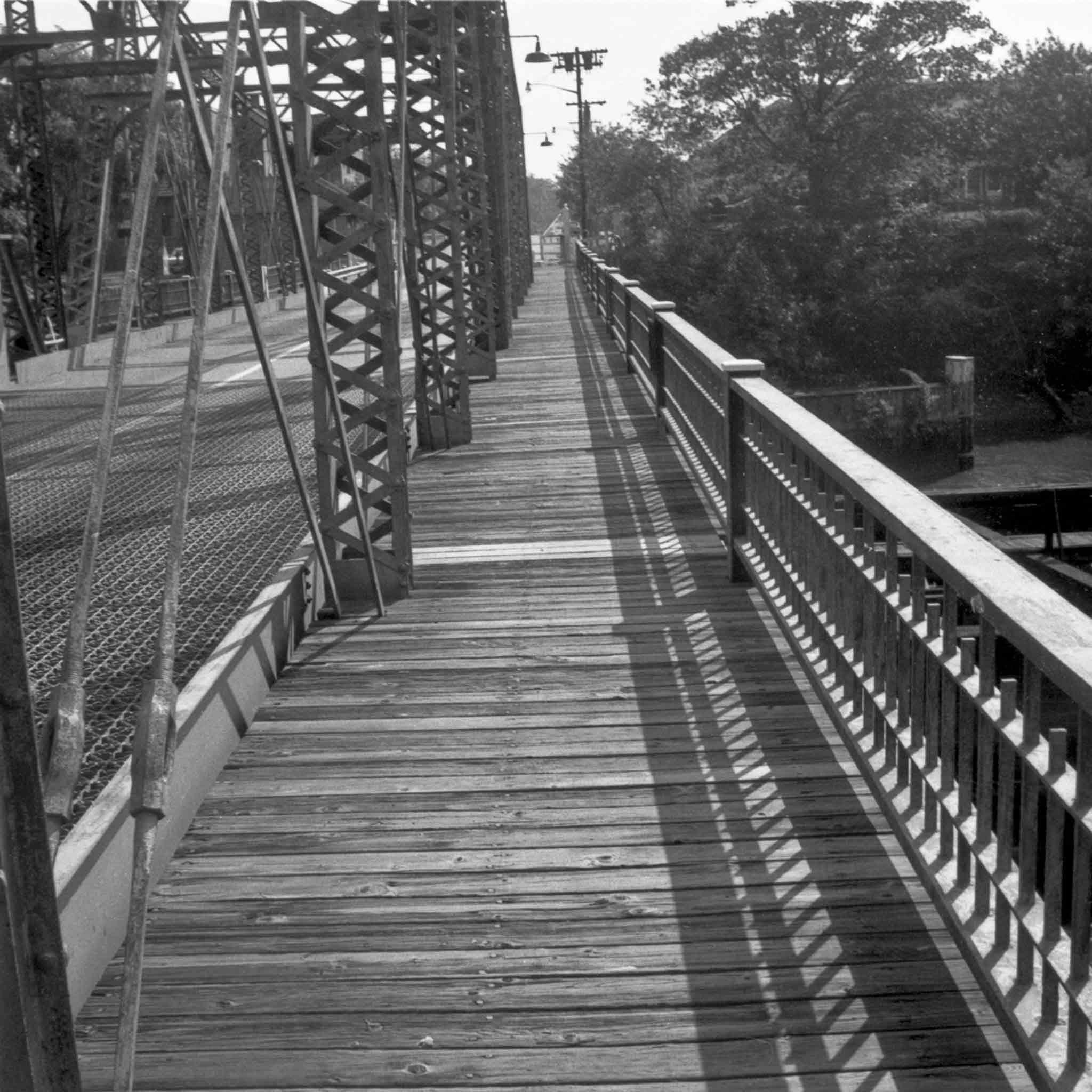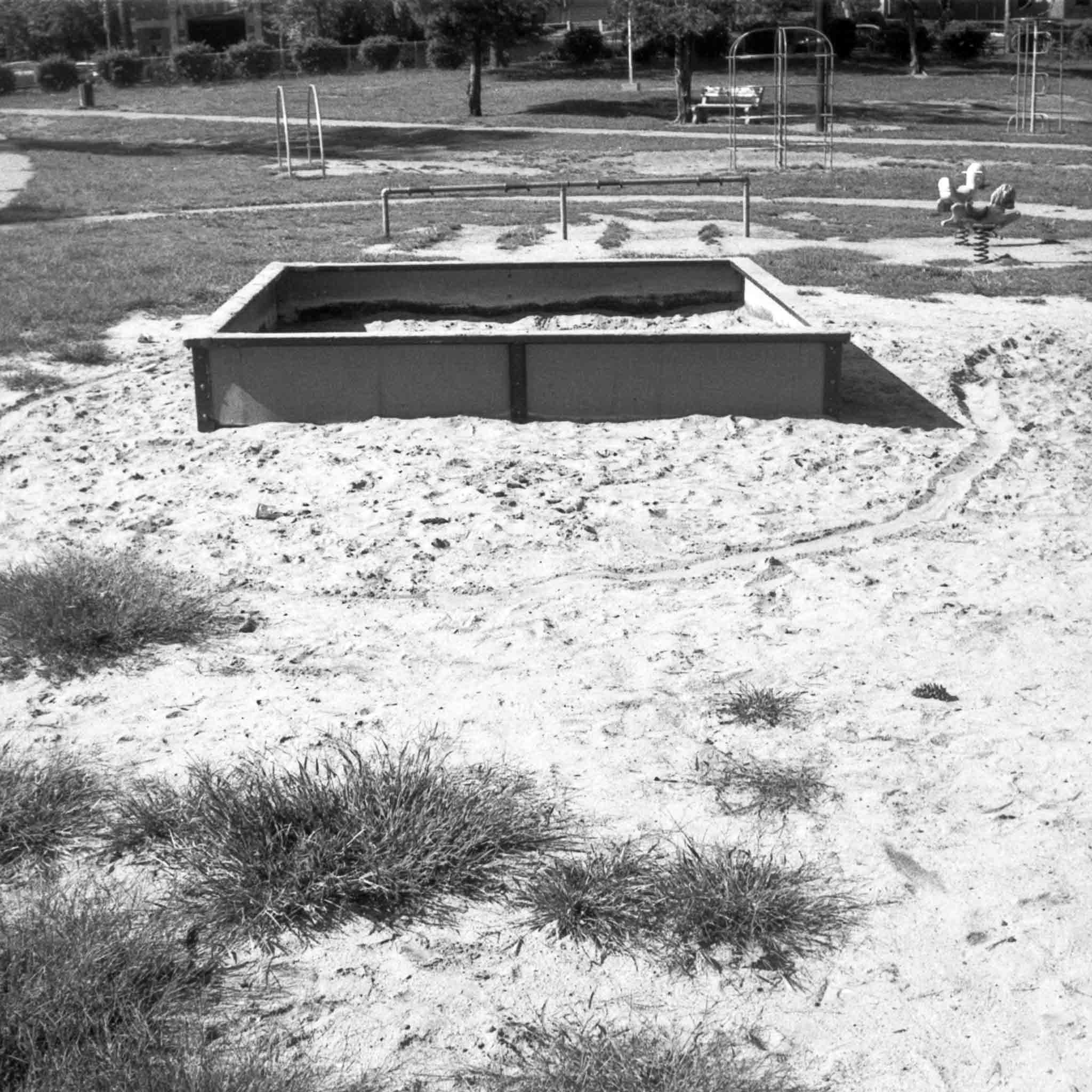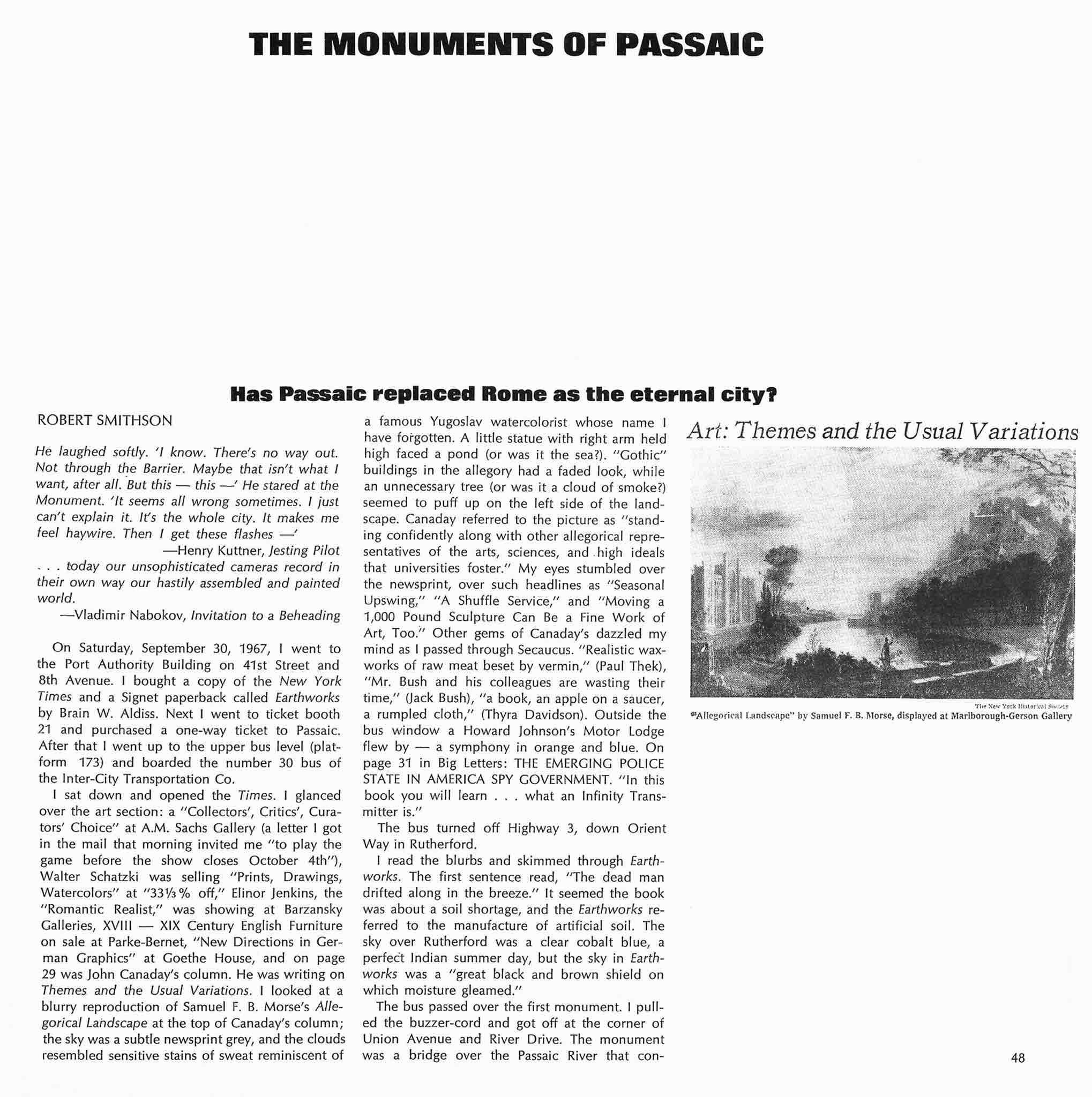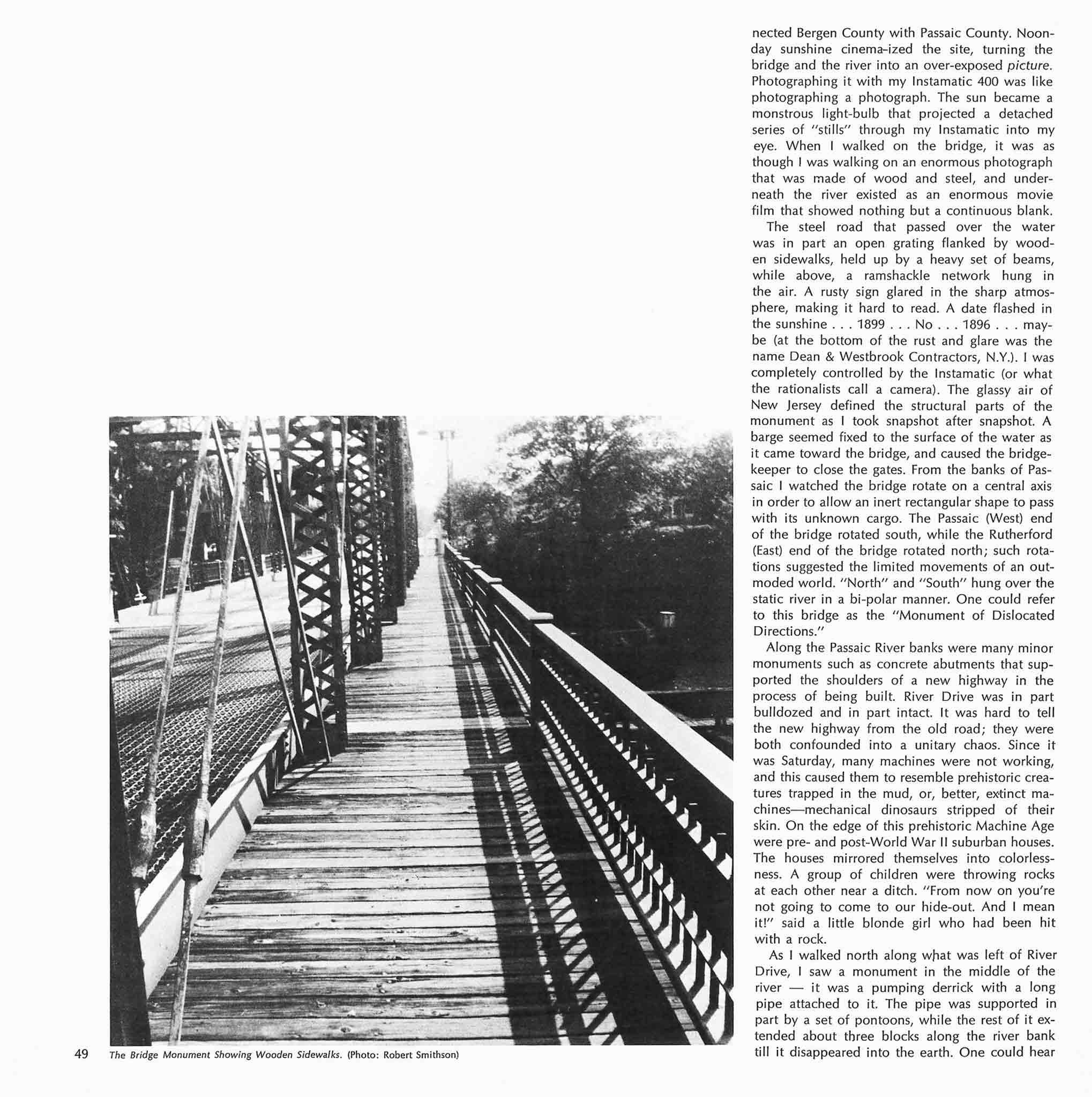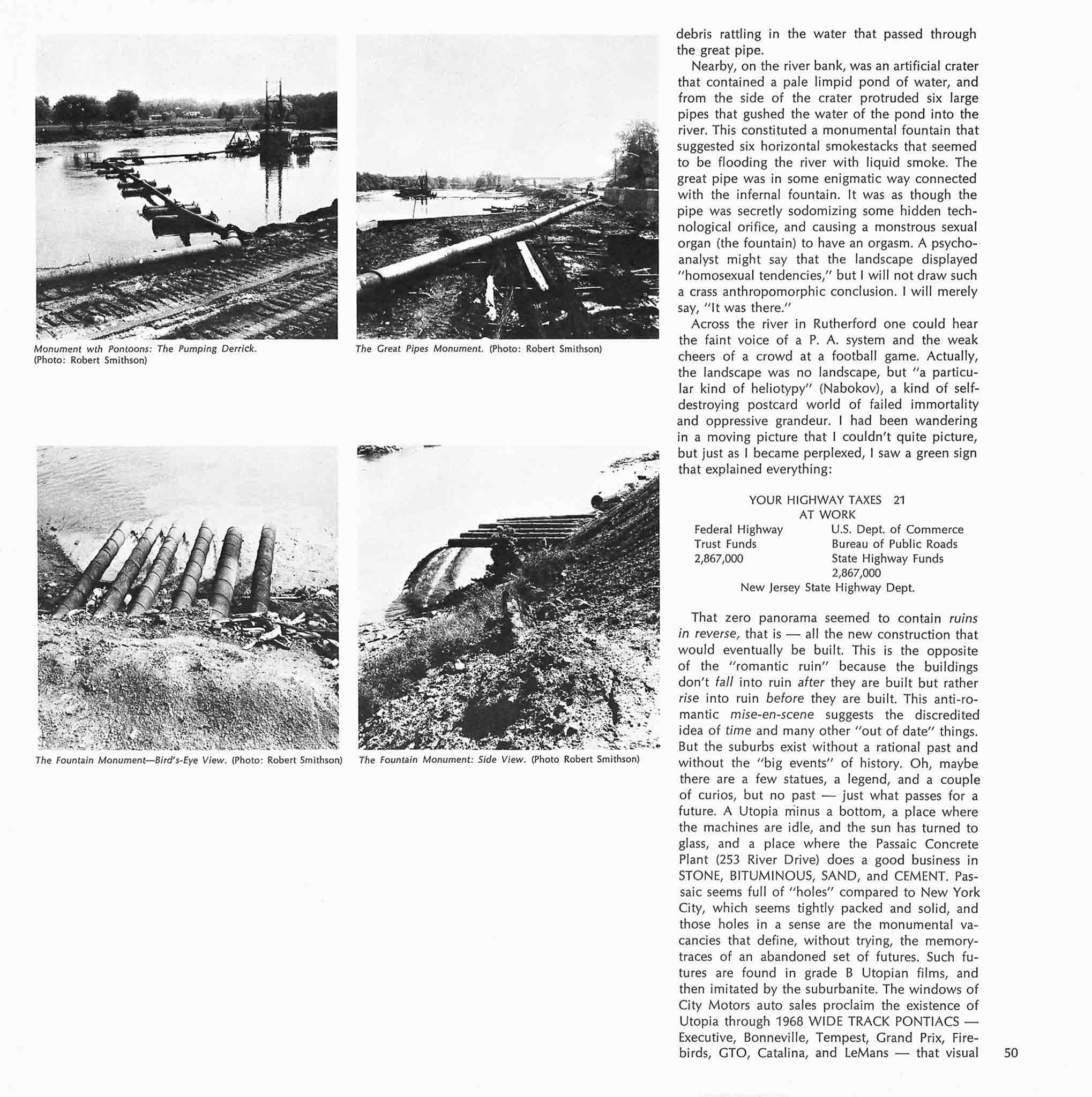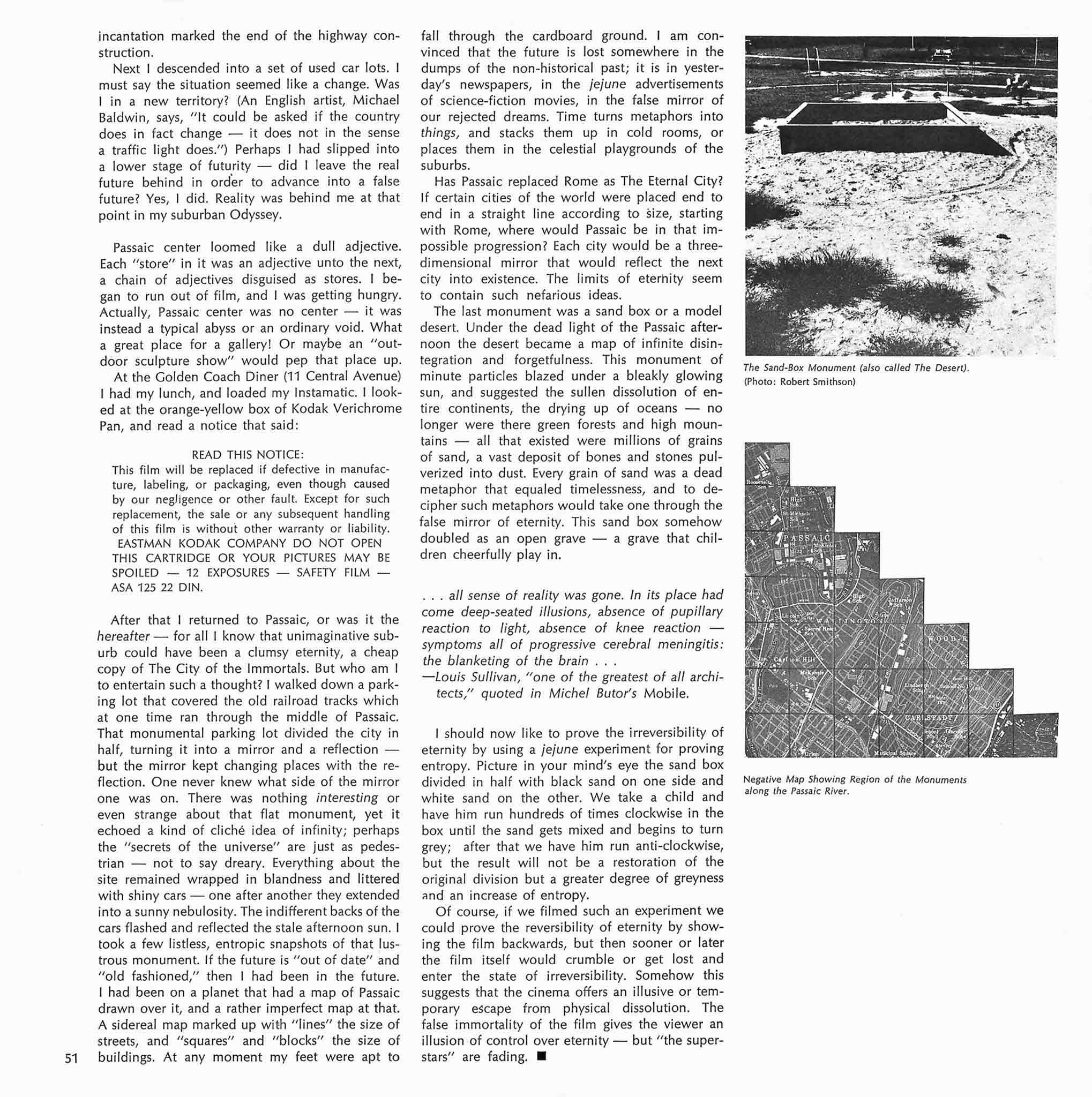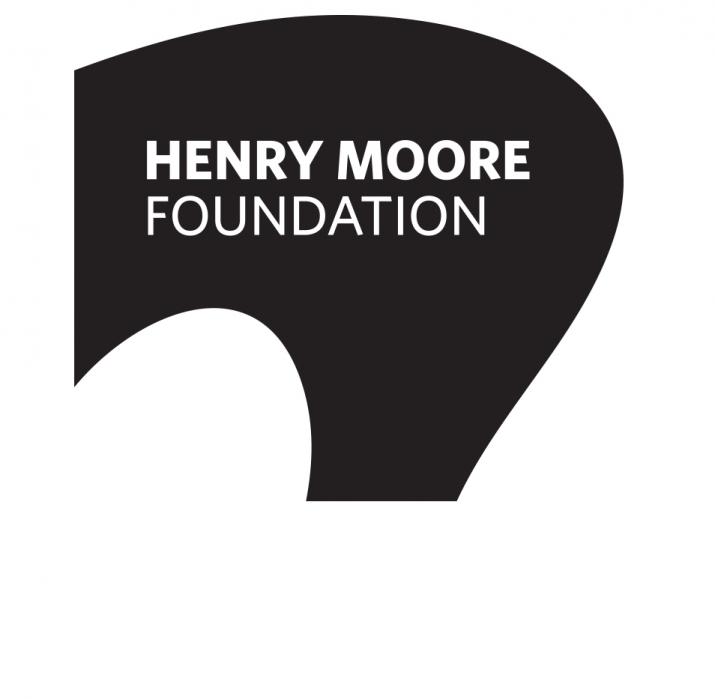
Robert Smithson’s Fictions: A Speculative Reading of “The Monuments of Passaic”
Robert Smithson prophesied “The true fiction eradicates the false reality.”1 Here, “false reality” signifies a world preconditioned by representational systems that have become naturalized to the point of invisibility, and Smithson perceives fiction as an apocalyptic force that at once destroys and recreates the real.2 First published in the December 1967 issue of Artforum, Smithson’s essay “The Monuments of Passaic” recounts his perambulations through New Jersey, punctuated by self-reflexive meditations on the act of photographing its ironically named “monuments”—the ephemeral material culture of a suburban landscape under (de)construction. For Smithson, monuments represent eternal markers of modern historical progress, and his vision of Passaic as a postmodern wasteland in a state entropic decline aims to subverts this conventional narrative.
A Tour of the Monuments of Passaic is a complex and multilayered work. It began with a draft essay written prior to the artist’s actual excursion to the terrain vague of the New Jersey suburbs that resulted in the Artforum essay, and includes seven rolls of photographs in addition to the six published in his essay.3 Smithson’s practice consistently investigated the ways context and mediation shape experience. The complicated question of what precisely constitutes the artwork in his Passaic project—the reproduced magazine article, the individual framed photographs existing as objects in museum collections, and/or the array archival materials?—amplifies his intention to destabilize the ontology of the work of art. While the essay—comprised of original text, literary citations, photographs, and a map— has the trappings of an anthropological travelogue, Smithson distorts the positivism of this genre to create an experimental narrative form shaped by the literature of science fiction and metafiction, the influence of which is signaled by the two epigraphs that frame his essay4 :
He laughed softly. “I know. There’s no way out, not through the Barrier. Maybe that isn’t what I want, after all. But this—this—" He stared at the Monument. “It seems all wrong sometimes. I just can’t explain it. It’s the whole city. It makes me feel haywire. Then I get these flashes.”
—Henry Kuttner, Jesting Pilot (1947)
Today our unsophisticated cameras record in their own way our hastily assembled and painted world.
—Vladimir Nabokov, Invitation to a Beheading (1935)
Kuttner and Nabokov’s dystopian stories correspond with one another via their inquiry into the illusory nature of reality. While Kuttner’s Jesting Pilot describes a false utopia whose citizenry lives under hypnosis and critiques the mystifications of ideology, Nabokov’s novel is more metaphysical in its conception. The protagonist Cincinnatus C. is imprisoned for the crime of “gnostical turpitude,” a state of “fleshy incompleteness […] as if one side of his being slid into another dimension.”5 Intuiting that reality is a construct, he is haunted by the possibility that his literal prison is a metaphor for the world’s monstrous dualism: “I am here through an error—not in this prison, specifically, but in this whole terrible striped world; a world which seems not a bad example of amateur craftsmanship, but is in reality calamity, horror, madness, error.”6
Sci-fi and metafiction are aligned in their critique of realism, and Smithson draws upon their themes and techniques to defamiliarize the banal reality of Passaic. Yoking together science and fiction to create a neologism, science fiction works through the interplay of antithetical systems of knowledge, and the genre’s capacity to produce radically other worlds destabilizes the hierarchy between fact and fiction and calls the authority of the reader’s empirical reality into question. Metafiction shares the world-building vision of sci-fi, its subject being fictional systems and the ways these produce rather than reflect the world. Metafictional writers challenge the positivist claims of realism by calling attention to the artifice of their texts and, for the critic Robert Scholes, this means “not a turning away from reality, but an attempt to find more subtle correspondence between the reality which is fiction and the fiction which is reality.”7
At the outset of his suburban odyssey, Smithson purchases the 1965 novel Earthworks by Brian W. Aldiss, observing that, “It seemed the book was about a soil shortage, and the Earthworks referred to the manufacture of artificial soil. The sky over Rutherford was a clear cobalt blue, a perfect Indian summer day, but the sky in Earthworks was a ‘great black and brown shield on which moisture gleamed.’”8 Shifting between empirical observation and textual description, Smithson superimposes the speculative world of Earthworks upon the actual landscape to dislocate the reader from the present into a science fictional future. Interpreting Aldiss’s concept of artificial soil as an ontological proposition, Smithson doubts the bedrock of his own reality as well: “At any moment my feet were apt to fall beneath the cardboard ground.”9 Indeed, the speculative world of Earthworks appears to be already present in Passaic, a place with “no past, just what passes for the future. […] such futures are found in grade B Utopian films, then imitated by the suburbanite.”10 For Smithson, fiction precedes reality, and the sci-fi imaginary provides a blueprint for the present.
The suburbs’ replication of the “jejune advertisements of science fiction movies” constitutes one aspect of their unreality, yet, there are more profound ontological doubts at work.11 Standing before the “Bridge Monument” (fig. 1) Smithson fantastically describes how,
Noon-day sunshine cinema-ized the site, turning the bridge and the river into an over exposed picture. Photographing it with my Instamatic 400 was like photographing a photograph. The sun became a monstrous light-bulb that projected a detached series of “stills” through my Instamatic into my eye. When I walked on the bridge, it was as though I was walking on a huge photograph that was made of wood and steel.12
Existing as a photograph of itself, the monument unsettlingly collapses the distance between the artist’s direct perceptions and the viewer’s vicarious experience of them through photographic reproductions.13 But science fiction can make sense of this uncanny perception. The author and critic Samuel Delany argues that a defining trope of sci-fi is its literalization of metaphor, and asks readers to consider the following phrase:
“Then her world exploded.” In realist fiction, we would read this as an emotionally muzzy metaphor about the specifically emotional aspect of some incident in a woman’s life. In sf, we must retain the margin to read this sentence in such a way that a planet, belonging to some woman, blew up.14
For Delany, the actual materialization of metaphor in science fiction allows readers to transcend the conventional orders and meanings of reality by positing the fantastic and imaginative impossibilities evoked by figurative speech as facts. Smithson was invested in the same ideas, and in his 1967 essay “Language to be Looked and/or Things to Read” he suggests that the 1960s “the mania for literalness relates to the breakdown of rational belief in reality.”15 While Smithson’s statement can be read in the context of minimalism’s pursuit of the real via its concrete materialism, it also bears witness to the ealization of science fictional metaphors in in an increasingly unreal world. Using Delany’s sci-fi reading protocols, the reader accepts the possibility that Smithson’s experience of Passaic—which literalizes the metaphor of the picturesque—actually unfolds within the space of a picture. But what accounts for this simulacral fusion of reality and representation? Composed of a sharp linear grid receding into the distance, “The Bridge Monument” perfectly diagrams illusionistic perspective, which Smithson critiqued as an anthropomorphic system that a priori transforms the world into a picture. Smithson saw the camera as the technological apotheosis of perspective, and being “completely controlled by the Instamatic,” he cannot see beyond its framing edge.16
Smithson and Nabokov’s metafictional gambits are widely interpreted as instances of postmodern deconstruction, but a radically alternative interpretation is possible: metafiction is a cypher for metaphysics. Invitation to a Beheading is suffused with Gnostical themes, and the artificial weave of the novel and the tears in its fabric are a grand metaphor for an illusory reality.17 The novel concludes with the execution of Cincinnatus C., and at the moment of his death, the “hastily assembled and painted world” is destroyed: “Little was left of the square. The platform had long since collapsed in a cloud of reddish dust. […] The fallen trees lay flat and reliefless […] Everything was coming apart. Everything was falling.”18 Smithson’s essay ends on an apocalyptic note as well. Meditating on the “The Sandbox Monument” (fig. 2), he is possessed by a vision of entropic annihilation: “Under the dead light of the Passaic afternoon the desert became a map of infinite disintegration and forgetfulness. This monument of minute particles […] suggested the sullen dissolution of entire continents, the drying up of oceans.”19 The reality recorded by Smithson’s photographs—which “gives the viewer an illusion of control over eternity”—begins to fade, and an entropic consciousness (symbolized by the sandbox desert) is awakened within which one merges with a world liberated from the rule of images, language, and systems.20 Ultimately, Smithson’s estrangement of the suburban banal produces a metaphorical destruction that creates space for the true fiction to replace the false reality.
Selected Bibliography
Delany, Samuel. The Jewel-Hinged Jaw. Elisabethtown, New York: Dragon Press, 1977.
Flam, Jack, ed. Robert Smithson: The Collected Writings, Los Angeles: University of California Press, 1996.
Henry Kuttner, “Jesting Pilot.” In Cities of Wonder, edited by Damon Knight, 51-63. New York: MacFadden-Bartell, 1967.
Nabokov, Vladimir. Invitation to a Beheading (trans. Dmitri Nabokov), New York: Vintage Books, 1989.
Robert Scholes, Fabulation and Metafiction. Chicago, London and Urbana: University of Illinois Press, 1980.
About the Author
Rory O’Dea is Assistant Professor of Contemporary Art and Design, and the Associate Dean of the School of Art and Design History and Theory at the Parsons School of Design. He received his Ph.D. in art history from the Institute of Fine Arts at New York University, and his scholarship explores the intersection of visual art, fiction, and consciousness. He has previously taught at the Yale University School of Art, and also worked as a researcher at the Whitney Museum of American Art, the Morgan Library and Museum, and the Grey Art Gallery at New York University.
With support from Henry Moore Foundation

Holt/Smithson Foundation's Scholarly Text Program has been funded in part through the generosity of the Henry Moore Foundation Grants Program.
- 1While a “true fiction” is inherently paradoxical, Smithson frequently combines irreconcilable ideas in order to activate his audience in the creation of new possibilities that exceed the limits of each. Robert Smithson, “Incidents of Mirror-Travel in the Yucatan” (1969), in Robert Smithson: The Collected Writings, ed. Jack Flam (Berkeley, Los Angeles, London: University of California Press, 1996), 123.
- 2Elsewhere, Smithson argues that, “The fictional betrays its privileged position when it abdicates to a mindless realism […] Fiction is not believed to be part of the world. Rationalism confines fiction to literary categories in order to protect its own interests or systems of knowledge.” Smithson, “A Museum of Language in the Vicinity of Art” (1968), in RSCW, 83-84.
- 3For a meticulous account of Smithson’s process notebooks and the archival materials related to his Passaic project, see Ann Reynolds, Robert Smithson: Learning from New Jersey and Elsewhere (Cambridge, MA and London: MIT Press, 2003), 100-104. For a detailed analysis of the photographs not published in the Artforum essay, see Jennifer L. Roberts, Mirror-Travels: Robert Smithson and History (New Haven and London: Yale University Press, 2004), 60-85.
- 4Smithson, “A Tour of the Monuments of Passaic, New Jersey,” in Robert Smithson: The Collected Writings, 68. Smithson’s epigraph citations are taken from the following editions, which he owned in his library: Henry Kuttner, “Jesting Pilot,” in Cities of Wonder, ed. Damon Knight (New York: MacFadden-Bartell, 1967); Vladimir Nabokov, Invitation to a Beheading, trans. Dmitri Nabokov (New York: Capricorn Books, 1959). Subsequent references to Invitation to a Beheading in this essay refer to the following edition: Vladimir Nabokov, Invitation to a Beheading trans. Dmitri Nabokov (New York: Vintage Books, 1989).
- 5Nabokov, Invitation to a Beheading, 72.
- 6Ibid., 91.
- 7Robert Scholes, Fabulation and Metafiction (Chicago, London and Urbana: University of Illinois Press, 1980), 8. Smithson owned an earlier iteration of this same topic: Scholes, The Fabulators (Oxford: Oxford University Press, 1967).
- 8Smithson, “A Tour of the Monuments of Passaic, New Jersey,” 69. For an incisive study of Smithson and Brian Aldiss, see Suzaan Boettger, “Digging into Aldiss’s Earthworks and Smithson’s Earthworks,’ Art Journal Open, accessed May 31, 2019, https://artjournal.collegeart.org/?p=9939.
- 9 Ibid., 74.
- 10Ibid., 72.
- 11 Ibid., 74.
- 12Ibid., 70.
- 13Throughout the essay, he confirms his vivid sense of the photographic quality Passaic, and insists that, “the landscape was no landscape, but ‘a particular type of heliotypy’ (Nabokov), a kind of self-destroying postcard world […] I had been wandering in a picture I couldn’t quite picture.” Smithson, “A Tour of the Monuments of Passaic, New Jersey,” 70.
- 14Samuel R. Delany, The Jewel-Hinged Jaw (Elisabethtown, New York: Dragon Press 1977), 284. “SF” is a term used to encapsulate both science fiction and speculative fiction.
- 15Smithson, “Language to be Looked at and/or Things to be Read,” in Robert Smithson: The Collected Writings, 61.
- 16Smithson, “A Tour of the Monuments of Passaic, New Jersey,” 70. Significantly, Smithson described the representation mediation of the world in terms of imprisonment or entrapment: “Everything comes back to that entrapment. Part of the idea of Nonsites is that we can’t help but bring things back to a square shape, to a rectangular situation, no matter how irregular we think we are or how free and infinite we think we are, we end up locked in. That’s what I was trying to talk about in terms of the prison idea; inside you think there’s a prison, and then you go outside and there’s another one.” Kenneth Baker, “Talking with Robert Smithson,” in Robert Smithson Spiral Jetty: True Fictions, False Realities, ed. Lynne Cooke (Berkeley: University of California Press; New York: Dia Art Foundation, 2005), 156.
- 17In a 1973 interview, Smithson describes his own fascination with “Gnostic heresies.” See Robert Smithson and Paul Cummings, “Interview with Robert Smithson for the Archives of American Art” (1972), in Robert Smithson: The Collected Writings, 286. He also explores Gnostic themes in his essay “Ultramoderne” (1967) and “From Ivan the Terrible to Roger Corman or Paradoxes of Conduct in Mannerism as Reflect in Cinema” (1967).
- 18Nabokov, Invitation to a Beheading, 223.
- 19Smithson, “A Tour of the Monuments of Passaic,” 74.
- 20Ibid., 74. In part, Smithson saw entropy as a dissolution of subject-object relations, which produced a quasi-mystical loss of self in union of mind and matter. In a 1969 interview, he postulates that, “The existence of “self” is what keeps everybody from confronting their fears about the ground they happen to be standing on. […] A site at zero degree, where the material strikes the mind, where absences become apparent, appeals to me, where the disintegrating of space and time seems very apparent. Sort of an end of selfhood…the ego vanishes for a while. See Smithson, “Fragments of an Interview with P.A. Norvell,” in Robert Smithson: The Collected Writings, 193-194. Nabokov also evoked a similar type of visionary experience that he described in terms of “cosmic synchronization,” which was marked by a feeling of “a oneness with basic reality.” This intense dissolution of rational subject-object boundaries is described by the eponymous character in the novel Pnin as the intense sensation of being “porous and pregnable,” “of sinking and melting into one’s physical surroundings.” See Nabokov, Speak, Memory (New York: Putnam, 1966), 218; and Nabokov, Pnin (London: Penguin Books, 2000), 17, 109.
O’Dea, Rory. "Robert Smithson’s Fictions: A Speculative Reading of 'The Monuments of Passaic.'" Holt/Smithson Foundation: Scholarly Texts Chapter 2 (July 2020). https://holtsmithsonfoundation.org/robert-smithsons-fictions-speculative-reading-monuments-passaic.
